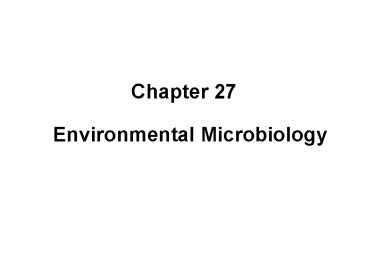Environmental Microbiology - PowerPoint PPT Presentation
1 / 23
Title:
Environmental Microbiology
Description:
Produce specialized enzymes (extremozymes) that allow them to tolerate extreme conditions ... Denitrification occurs in waterlogged soils. Little oxygen available ... – PowerPoint PPT presentation
Number of Views:911
Avg rating:3.0/5.0
Title: Environmental Microbiology
1
Chapter 27
- Environmental Microbiology
2
Metabolic Diversity
- Microbes live in the most widely varied habitats
on Earth - due to metabolic diversity
- allows them to take advantage of an available
niche - Extremophiles
- Most are Archaea
- Produce specialized enzymes (extremozymes) that
allow them to tolerate extreme conditions
3
- Microbes live in an intensely competitive
environment - May out compete other microbes
- May make an environment uninhabitable for others
- Sometime they live in symbiosis
- Ruminants
- Mycorhizae
- Endomycorrhizae hyphae penetrate the plant root
- Form storage vesicles and digestive arbuscules
- Ectomycorrhizae form mycelial mantle over roots
of trees - Truffles
4
Endomycorrhiza
Ectomycorrhiza
5
(No Transcript)
6
- Billions of organisms are in soil
- Over 80 are bacteria
- Millions in each gram of soil
- Most are in the top few centimeters of soil
- Many antibiotics come from Actinomycetes
- Streptomycin, tetracycline
- Bacterial populations may be estimated by plate
counts - Underestimates number
7
- Biochemical cycles for carbon, nitrogen, sulfur
and phosphorus are vital for life - Elements are oxidized and reduced by microbes to
meet their metabolic need - This recycles the elements into the environment
8
The Carbon Cycle
- All organisms contain large amounts of carbon
- Autotrophs reduce CO2 to form organic matter
- Chemoautotrophs also fix CO2 into organics
- 1st step of carbon cycle
- Chemoheterotrophs consume autotrophs
- 2nd step of carbon cycle
- Carbon reenters the environment as CO2
- due to respiration decomposition by microbes
burning fossil fuels - Global warming
9
(No Transcript)
10
The Nitrogen Cycle
- Nitrogen is needed by all organisms
- synthesis of proteins and nucleic acids
- About 80 of the Earths atmosphere
- To be used by plants it must be fixed
- Specific microbes are important in this
conversion - Deamination amino groups are removed and
converted to ammonia - Ammonification- release of ammonia
11
- Nitrification is the oxidation of the nitrogen in
ammonium into nitrate - Denitrification nitrate can be fully oxidized
and used as an electron acceptor - Can lead to a loss of nitrogen back to the
atmosphere as nitrogen gas - Pseudomonas species are the most important soil
denitrifying bacteria - Denitrification occurs in waterlogged soils
- Little oxygen available
- Use nitrate as final electron acceptor
12
Nitrogen Cycle
Microbial decomposition
Proteins and waste products
Amino acids
Microbial ammonification
Amino acids (NH2)
Ammonia (NH3)
Nitrosomonas
Ammonium ion (NH4)
Nitrite ion (NO2- )
Nitrobacter
Nitrite ion (NO2-)
Nitrate ion (NO3- )
Pseudmonas
Nitrate ion (NO3-)
N2
Nitrogen - fixation
N2
Ammonia (NH3)
13
(No Transcript)
14
- Nitrogen fixation relies on nitrogenase
- Deactivated by oxygen
- Two types of nitrogen fixers
- Free-living found in rhizosophere
- Aerobic species - Azotobacter and Beijerinckia
- Anaerobic species - Clostridium
- Many aerobic cyanobacteria heterocysts
- Symbiotic
- Rhizobia form root nodules on legume plants
- Frankia forms association with alder trees
- Lichens contribute when they contain a
cyanobacteria - Cyanobacteria Azolla grows in rice patty water
15
(No Transcript)
16
The Sulfur Cycle
- Involves numerous oxidation states
- Most reduced forms are sulfides like H2S gas
- Generally forms under anaerobic conditions
- Source of energy for some autotrophic bacteria
- Convert reduced sulfur in H2S into elemental
sulfur and oxidized sulfates - Winogradsky studied filamentous aquatic bacteria
Beggiatoa - Revealed much about bacterial sulfur recycling
- Several photoautotrophic bacteria oxidize H2S
- Use light for energy and use H2S to reduce CO2
17
- Sulfates are incorporated into plants, animals
and bacteria as disulfide bonds in proteins - As proteins decompose sulfur is released as H2S
- Dissimilation
- Sulfur is used as a energy source by Thiobacillus
- Grow well at low pH have practical uses in mining
18
- Entire populations of organisms live with out
photosynthesis by using H2S for energy - Bacteria around deep sea thermal vents are
isolated from sunlight - Primary producers are chemoautotrophs
- Bacterial called endoliths have been discovered
deep within rocks - Little oxygen and nutrients are available
- Use sulfur reduction as an energy source
19
Sulfur Cycle
Microbial decomposition
Proteins and waste products
Amino acids
Microbial dissimilation
Amino acids (SH)
H2S
Thiobacillus
H2S
SO42 (for energy)
Microbial plant assimilation
SO42
Amino acids
20
- Primary producers in deep ocean and endolithic
communities are chemoautotrophic bacteria
Provides energy for bacteria which may be used to
fix CO2
H2S
SO42
Calvin Cycle
CO2
Sugars
Provides carbon for cell growth
21
(No Transcript)
22
The Phosphorus Cycle
- Limiting factor for plant and animal growth
- Exists primarily as phosphate ion (PO43-)
- Undergoes very little change as oxidized
- Involves changes from soluble to insoluble forms
- Can be solubilized in rock be acids produced by
bacteria like Thiobacillus - There is no product to return it to atmosphere
- Accumulates in sea certain islands are mined for
phosphate deposits - Used in detergents and fertilizers
23
The Phosphorous Cycle































